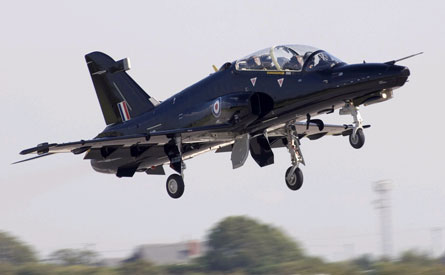BAE Systems will use the Farnborough air show to offer a major package of upgrades for international users of the Hawk advanced jet trainer, while also promoting the latest-generation 128-model's capabilities to potential new customers.
"We will start offering a suite of upgrades later this year," says Michael Christie, BAE's senior vice-president Hawk international, whose responsibilities cover trainer business outside the UK.
The proposed enhancements will encompass "airframe, engine and avionics", he says, with the move having been prompted by the Royal Australian Air Force's need to perform a mid-life upgrade to its 33 Hawk 127s. The Bombardier-led NATO Flying Training in Canada system is viewed as another potential customer, he adds.
BAE is using the current record price of oil to highlight the fuel economy of its single-engined Hawk, and estimates that operating costs for the type could be half those of twin-engined or supersonic designs over a service life of 4,000-5,000 flight hours.
"You can't separate life extension from fuel consumption - it's becoming a real issue," says Christie. "I can see most of the larger air forces concentrating on life-cycle costs."
Countering competition charges that the aircraft lacks the dynamic performance of current fighter aircraft, Christie notes: "We designed the Hawk to go slower, because that's where the training regime is. There's enough dynamic performance to stress the pilot."
 |
|---|
© BAE Systems |
Saudi Arabia could be another potential customer for a package of upgrades, with BAE expecting to offer the nation a mix of new Hawk 128s and a modernisation package for some of its Hawk 65s to prepare pilots for operations with the Eurofighter Typhoon.
"There is no official requirement or budget, but there is clearly a need," says Christie. Riyadh's expected AJT contest was also one of the factors that led to Boeing recently partnering Alenia Aermacchi on the M-346. If launched, the project could be for more than 20 new aircraft, according to industry sources. BAE also continues to support Hawks operated by the United Arab Emirates, which has yet to advance its AJT contest since eliminating the new-generation 128 last October.
BAE meanwhile expects Singapore to issue a request for proposals for its AJT requirement around September, with the nation having evaluated the Hawk 128, M-346 and the Korea Aerospace Industries/Lockheed Martin T-50. However, sources suggest that this schedule could slip, with Singapore to potentially adjust its current procurement model, which precludes the airframers from also bidding as prime contractors for the training system.
India continues to look at a follow-on purchase of 40 Hawk 132s for its air force and 17 for its navy, with this to boost the nation's total purchase to 123 aircraft, and to potentially also seal a possible joint venture deal between BAE and Hindustan Aeronautics. The US Navy has also discussed interest in a T-45D version of the Boeing-modified Goshawk trainer. "I'm optimistic that at some point we will have more news on the USN and T-45," says Christie.
"We still believe the Hawk is in a good position for marketing around the world. We can give customers great value in targeting through-life costs, and through the upgrade market." While BAE has recently announced some Hawk-related redundancies, Christie says it is placing additional work at its Brough manufacturing site in Yorkshire to circumvent the cyclical nature of the trainer business. "At the moment, I don't see a cliff face," he adds.
The UK's first of 26 production-standard Hawk 128s is, meanwhile, poised to perform its first flight. Aircraft RT3 will follow two earlier development examples as part of the Ministry of Defence's AJT deal, with the Royal Air Force scheduled to approve the type's release to service during August.
EDS recently received a contract to provide the aircraft's mission planning and debrief system, while BAE will deliver embedded simulation equipment and CAE two full-mission simulators.
Source: Flight International
















